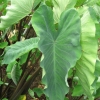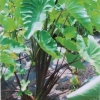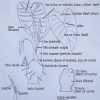Use As Food
Chiefly as table taro. Taro of Lauloa group were used by the early Hawaiians for medicinal purposes, chiefly in pulmonary disorders. They are now popular mainly as table taros and for poi.
Distribution
Found only occasionally among the other forms of Lauloa Palakea.
General Characteristics
Tall, erect, maturing within 9 to 12 months, producing from 5 to 10 ‘ohā; closely resembles Lauloa Palakea ‘Ele‘ele and Lauloa Palakea ‘Ula but differentiated by the pink Hā (Petiole) and kōhina (base).
Ha (Petiole)
100 to 140 cm. long, dark green heavily spreads across (suffused) the Hā (stem) with dark reddish-purple to blackish, especially on upper portion, purplish at top (apex), a brilliant pink ring at kōhina (base), distinctly reddish-pink to almost whitish at the lihi (edge).
Lau or Lu'au(Leaf Blade)
45 to 65 cm. long, 30 to 40 cm. wide, 35 to 50 cm. from tip to base of sinus (māwae), arrow head shaped, slightly concave (curve inward), dark green; margins with a few large undulations; piko purplish; veins purplish on lower surface of round leaf section (lobes); round leaf section (lobes) obtuse with narrow lihi māwae (sinus).
'I'o kalo (Corm)
Flesh white except for light pinkish tinge, especially near the top (apex), the fibers yellowish; skin pink.
Pua (Flower)
Hā (peduncle) yellowish, flecked with green and purple; flower cover (spathe) 20 to 24 cm. long, the lower tubular portion about 4 cm, long, light purplish, the upper portion medium yellow with reddish lihi (edge); spadix (spike of flower) 8 to 10 cm. long, the sterile appendage (tip of flower's spike) 11 mm. long.
Remarks
















